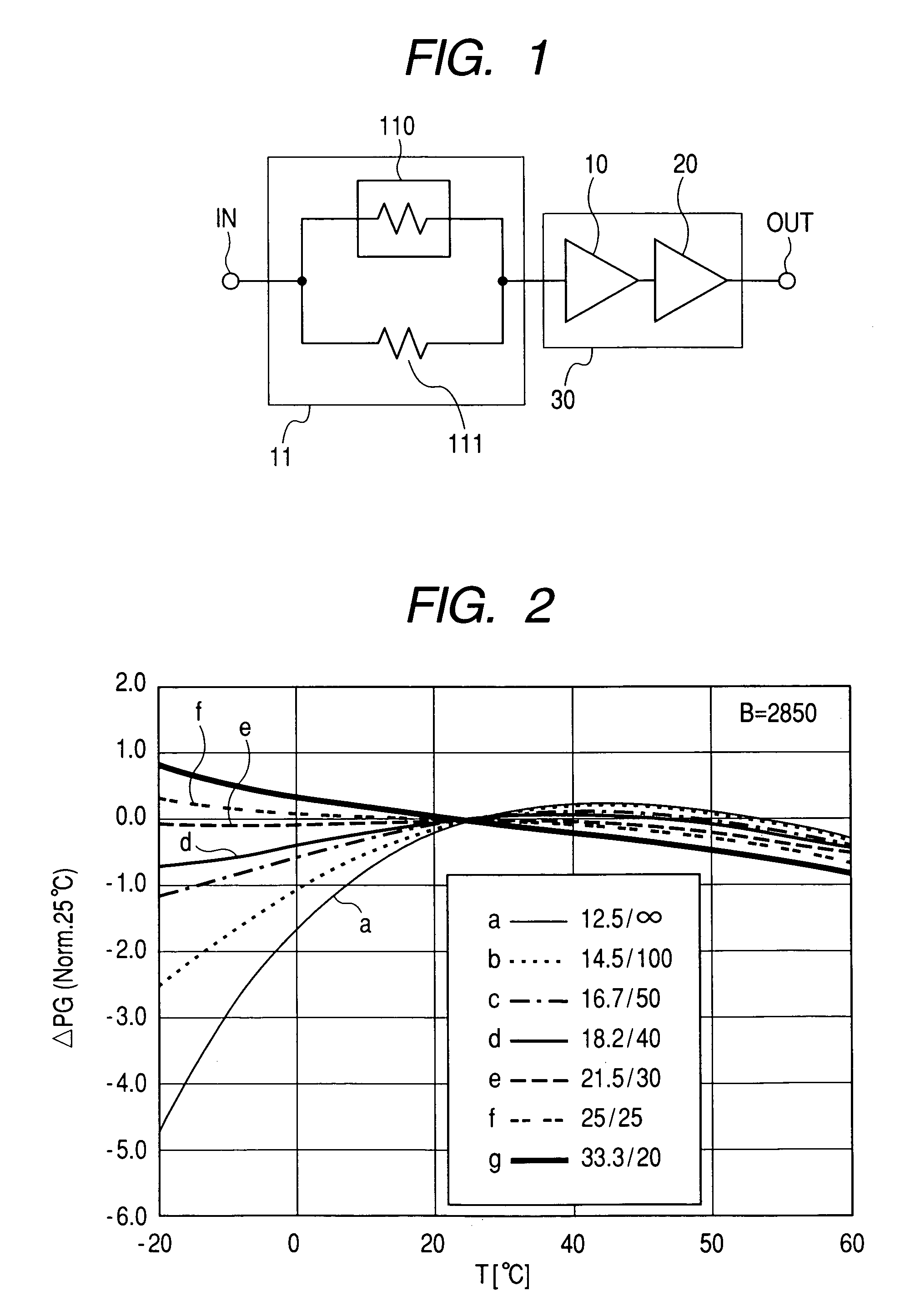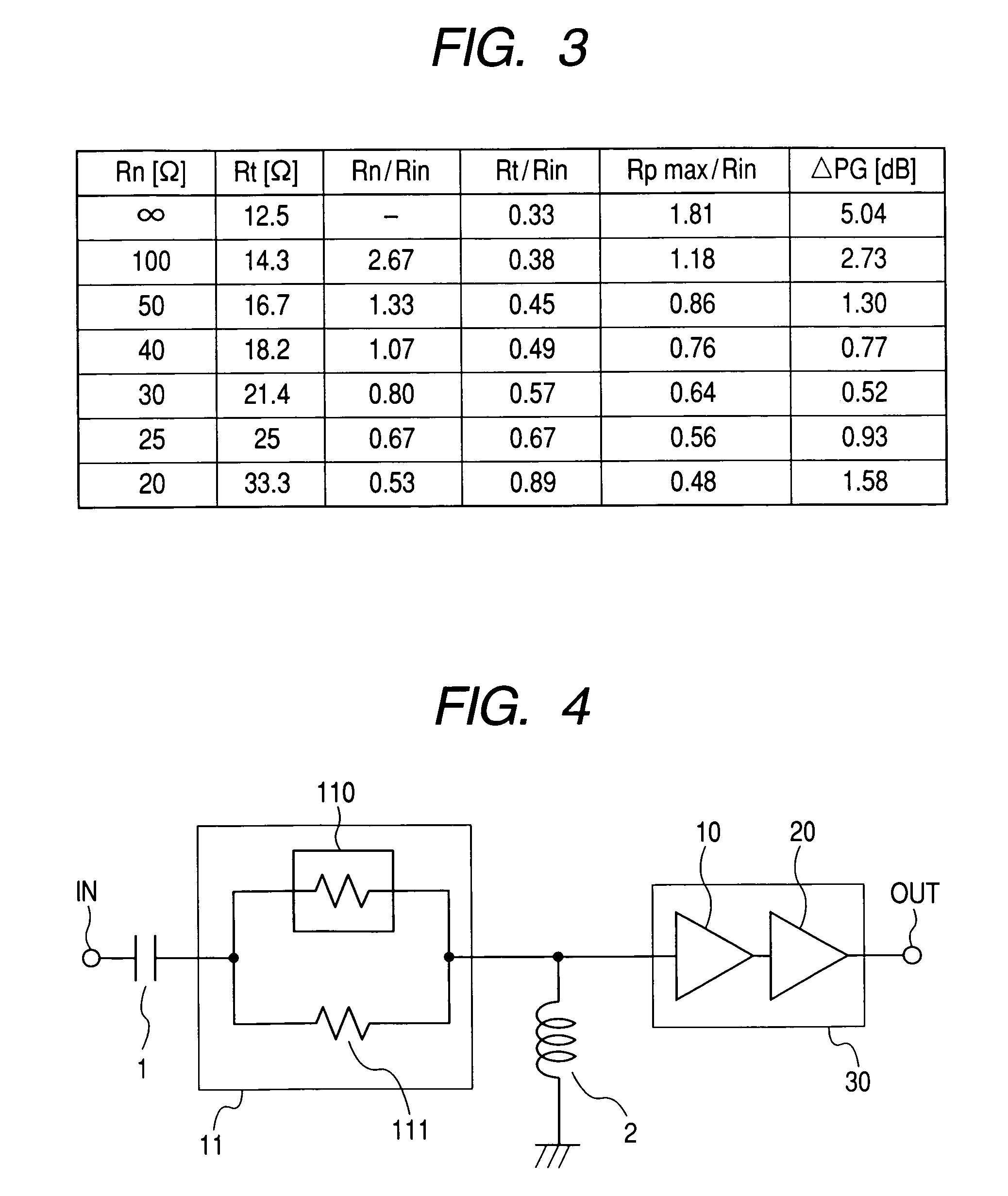High frequency power amplifier
a high-frequency power amplifier and amplifier technology, applied in amplifier modifications to reduce noise influence, amplifiers with field-effect devices, solid-state devices, etc., can solve problems such as unstable first-stage amplifiers, time-consuming and laborious changes in terminal temperature, and increase terminal costs. , to achieve the effect of small temperature dependence of gain and excellent input matching
- Summary
- Abstract
- Description
- Claims
- Application Information
AI Technical Summary
Benefits of technology
Problems solved by technology
Method used
Image
Examples
embodiment 1
[0038]FIG. 1 is a circuit diagram showing a first embodiment of a high frequency power amplifier according to this invention. In FIG. 1, the reference numeral 30 denotes an amplifier unit, and this amplifier unit 30 is constructed in a two-stage configuration consisting of a first-stage amplifier 10 and a second-stage amplifier 20. The reference numeral 11 denotes an attenuator that is a parallel circuit consisting of a thermistor 110 having negative temperature dependence of the resistance and a resistor 111 whose temperature dependence of the resistance can be ignored in a normal operating range (hereinafter referred to as the conventional resistor). When an operating temperature range of the high frequency power amplifier was set as −20° C. to 80° C., the temperature dependence of the gain of the amplifier unit 30 was that a gain per stage of the amplifier decreased by about −2 dB almost linearly to the temperature in a high temperature side, and the temperature dependence of the...
embodiment 2
[0056]FIG. 4 is a circuit diagram showing a second embodiment of a high frequency power amplifier according to this invention. This embodiment differs from Embodiment 1 shown in FIG. 1 in that a series capacitor 1 is provided between the attenuator 11 consisting of the parallel resistors and the input terminal IN and an inductor 2 connected parallel between the attenuator 11 and the amplifier unit 30 is provided. The series capacitor 1 and the parallel inductor 2 constitute an input matching circuit of the amplifier along with the parallel resistor attenuator 11.
[0057]A situation of the matching will be described using the Smith chart of FIG. 5. An impedance when viewing the amplifier unit 30 from its input side is represented by A. The parallel inductor 2 converts the impedance on an equi-admittance circle and the impedance when viewing the amplifier side from a junction point of the parallel inductor 2 and the parallel resistor attenuator 11 becomes B.
[0058]Next, the parallel resi...
embodiment 3
[0068]FIG. 9 is a circuit diagram showing a third embodiment of a high frequency power amplifier according to this invention. In this embodiment, a parallel capacitor 4 and a series inductor 5 are provided in-stead of the parallel inductor 2 in FIG. 7. Other reference numerals are the same as those of other figures. The parallel capacitor 4 and the series inductor 5 along with the parallel resistor attenuator 11 constitute an input matching circuit of the amplifier unit. The situation of the matching is explained using the Smith chart of FIG. 10. An impedance when viewing the amplifier unit 30 from the input side is represented by A. The series inductor 5 converts the impedance on an equi-resistance circle, an impedance when viewing the amplifier unit 30 side from a junction point of the series inductor 2 and the parallel resistor attenuator 11 becomes E.
[0069]Next, the parallel resistor attenuator 11 converts the impedance on an equi-reactance circuit, so that an impedance when vie...
PUM
 Login to View More
Login to View More Abstract
Description
Claims
Application Information
 Login to View More
Login to View More - R&D
- Intellectual Property
- Life Sciences
- Materials
- Tech Scout
- Unparalleled Data Quality
- Higher Quality Content
- 60% Fewer Hallucinations
Browse by: Latest US Patents, China's latest patents, Technical Efficacy Thesaurus, Application Domain, Technology Topic, Popular Technical Reports.
© 2025 PatSnap. All rights reserved.Legal|Privacy policy|Modern Slavery Act Transparency Statement|Sitemap|About US| Contact US: help@patsnap.com



